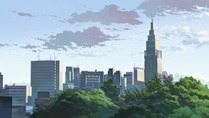 |
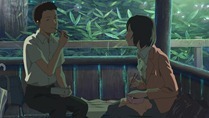 |
 |
When it comes to the visual side of anime – or animation – there’s Shinkai Makoto, and everyone else. Two different categories, period.
I spent a day at Shinjuku Gyoen National Garden this past Spring, during Sakura season. In fact I’ve gone there twice over the years and ironically, it was raining on both days. It was indeed very beautiful in the rain, but here’s the truly remarkable thing: the garden as depicted by Shinkai feels more real to me than the place I visited and saw with my own eyes. This isn’t a weak attempt at being clever, or hyperbole – it’s the absolute truth. And there’s perhaps no greater compliment I can pay to Shinkai-sensei’s gifts as an artist than that.
There are times when watching a Shinkai film where I wonder how it’s even possible that a human being can create animation of such surpassing beauty, and Kotonoha no Niwa is certainly no exception. There are images in Byousoku 5 Centimeter that remain peerless for me, and as a whole that remains my favorite Shinkai film. But Garden of Words is, on balance, probably the most beautiful animated film I’ve ever seen. In terms of background detail, fluid animation, exquisite and seamless use of CGI and sheer style it sets a new standard even for this director.
But you know, all that technical stuff doesn’t really begin to do justice to what Shinkai does. I can never seem to do better than the term that occurred to me after 5 CM to describe his vision: “more real than real”. Shinkai has a poet’s soul, and somehow he manages to see the essence of what makes something beautiful and capture it with art and animation that’s realistic, but transcends simple realism. The usual Shinkai standards are here: trains, birds, snow. There are also the loveliest character designs of his career, and a beautiful canvas upon which to paint in Shinjuku Gyoen. But the most stunning moments for me in Kotonoha no Niwa are when Shinkai captures the heartbreaking beauty of the mundane as only he can. Dust motes in a beam of sunlight. Flakes of chalk falling to the floor of a classroom. Drips of rain in a puddle, a water strider on a pond. No one in my experience has ever been able to find the exceptional in the ordinary the way Shinkai can, and I thank my lucky stars every day that he chose anime as the outlet to express his vision.
With a Shinkai movie, there’s always the question of whether the story will live up to the visual artistry. As I said earlier, to me Shinkai-sensei is a poet, and as such I think he works best working with spare, simple plots that express his keen sense of human emotion. I enjoyed Hoshi o Ou Kodomo very much, and I think it’s criticized more than it deserves to be. But that said, it’s easily Shinkai’s most prosaic work. It’s burdened with too much conventional plot and it’s too long, and neither of those elements play into Shinkai’s strengths. It feels too transparently like Shinkai’s attempt to make a Ghibli film, and Ghibli has already pretty much written the book on how to do that.
With Garden of Words, Shinkai has returned to his comfort zone, and the results are predictably impressive. As with Byousoku 5 CM this is a short film – barely 45 minutes – and an even simpler one in terms of plot. Shinkai has even used a poem as the device that ties the film together, a tanka that expresses much about the state of mind of the two leads:
A faint clap of thunder
Clouded skies, perhaps rain comes
Will you stay here with me?
This is the quote that Yukino Yukari (Kana Hanazawa) reads to young Akazuki Takao (Irino Miyu) on the morning of their first meeting in a gazebo at the old Imperial Garden. Takao is 15; Yukari, we later learn, is 27. The boy is sure he’s seen the woman somewhere before, but can’t say where. She’s drinking beer and eating chocolate, much to his horror. They don’t talk much – he sketches, surreptitiously staring at her from time to time, and she stares out at the pond in the rain, the Taiwan Pavilion an imposing sight on the far shore.
These scenes under the gazebo form the heart of this small, simple film. Akazuki is an odd sort, a daydreamer who loathes “that childish place” he’s required to attend and skips out every morning it rains to go to the garden. Akazuki’s dream is no ordinary one either – to make shoes for a living. As for Yukino-san it’s only clear that she’s troubled, running from something – she tells the boy she’s playing hooky from an office but there are obvious signs that she’s been suffering deeply. Eventually the beer turns into coffee, and the silence turns into quiet, friendly conversation as the boy inevitably falls in love with the woman.
If you’ve seen Shinkai’s films you’ve been down this emotional road before, and have some idea where it leads. I wouldn’t say Kotonoha no Niwa breaks any new ground for him, especially, and it lacks the incredible emotional resonance of the “Cherry Blossom” chapter from 5 CM Per Second – the longing so intense and pure that you felt it in every cell in your body. But it’s effective nonetheless, because this is a story Shinkai is temperamentally and stylistically suited to tell. While there are moments of intensity the tone of the film is mostly subdued and reflective, and it’s clear that Shinkai is stating his belief that two souls can connect even if the calendar makes it inconvenient for them to do so. It never seems anything other than natural that this boy – an old soul if ever one lived – should come to love a woman 12 years his elder, or that she should come to love him, even if circumstances (their age and the fact that, as it turns out, she was a teacher at his school) conspire against them.
I do miss the work of the supremely talented Tenmon with the music, though Kashiwa Daisuke does deliver a suitably mellow and reflective soundtrack. As with Hoshi o Ou Kodomo Shinkai has chosen to go with big-name seiyuu for the leads here, a departure from his philosophy earlier in his career. Hanazawa does quite well with the wounded, too-kind Yukino, wandering aimlessly through the wreckage of her life with only Akazuki-kun to cling to – we never forget whose voice it is we’re hearing, but she’s thankfully quite understated by her usual standard. It seems almost unnecessary to say that Miyu is superb – no seiyuu in anime handles quiet scenes of emotional depth and complexity better than he does. Miyu can be theatrical when he needs to be but his true mastery is in doing more with less, and in finding the emotional heart of the characters he plays. In that sense, he’s ideally suited to be Shinkai’s muse.
The emotional climax of the film comes on a day when the two haven’t seen each other for many weeks – the rainy season is over, and Takao hasn’t visited the park (well aware, perhaps, of how complicated things will become if he follows his heart). He decides to visit on a sunny day, desperate to see Yukino again, and as the day fittingly turns to spectacular rain delivers to her the answering verses of her tanka:
A faint clap of thunder
Even if the rain comes not,
I will stay here, together with you
Endings with Shinkai are always a matter of some consternation with his fans, it seems. There’s a sense of hope in this one, and it’s important that you watch the short scene after the credits to understand just where the film leaves Takao as a character. Practicalities are never glossed over in a Shinkai story – we’re a part of the world we live in, and our lives are affected by factors over which we have little control. But more so than with Byousoku 5 Centimeter there’s a sense here that the characters have taken a measure of control over their lives and come to understand what’s truly important to them. As with all of Shinkai-sensei’s films there’s less a feeling that we’ve reached the end of the characters’ stories but rather stopped between chapters, and that the story will continue once the cameras are turned off. In the case of Kotonoha no Niwa, those next chapters seem more hopeful than we’re used to – the feeling is that a world of possibilities exists for Takao, and that his life is only beginning.
 |
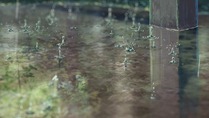 |
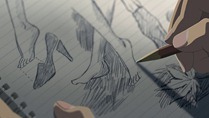 |
 |
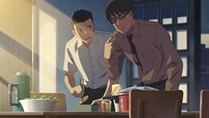 |
 |
 |
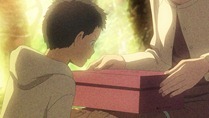 |
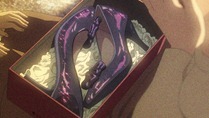 |
 |
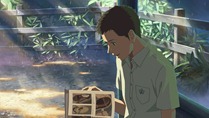 |
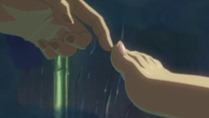 |
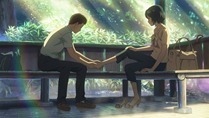 |
 |
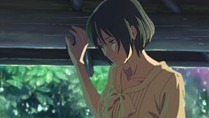 |
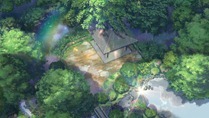 |
 |
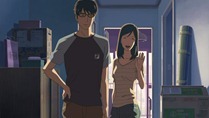 |
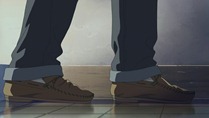 |
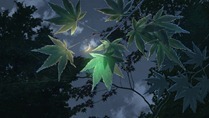 |
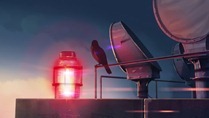 |
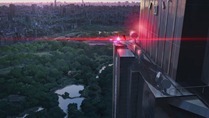 |
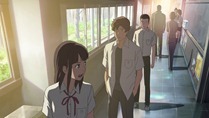 |
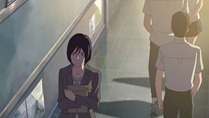 |
 |
 |
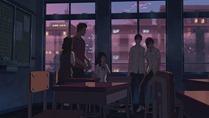 |
 |
 |
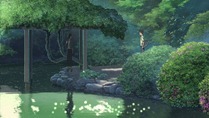 |
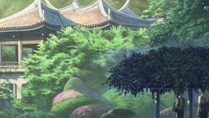 |
 |
 |
 |
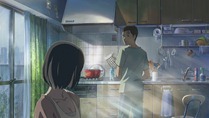 |
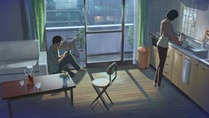 |
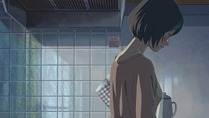 |
 |
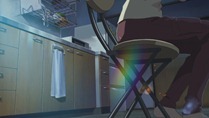 |
 |
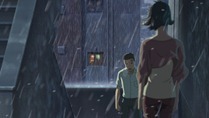 |
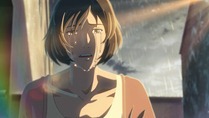 |
 |
 |
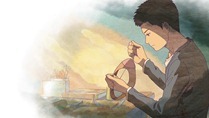 |
ED: “Rain” by Motohiro Hata
 |
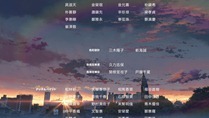 |
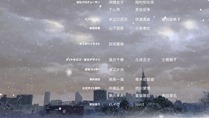 |
Epilogue:
 |
 |
 |
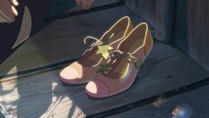 |
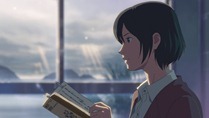 |
 |


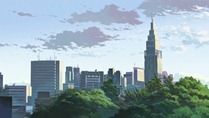

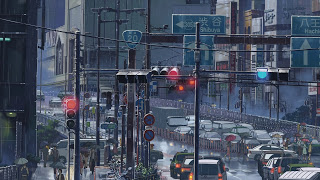
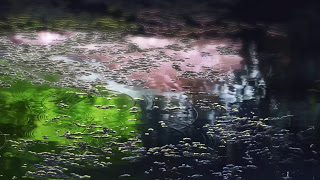
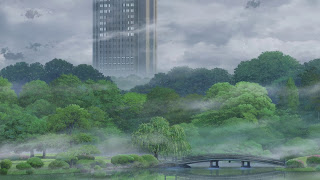
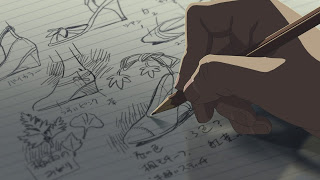
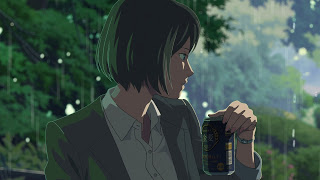
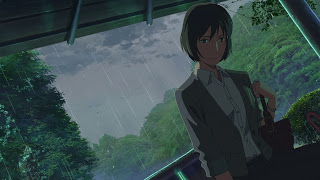
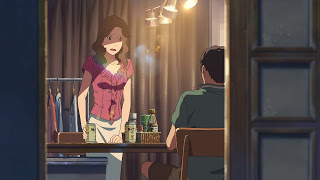
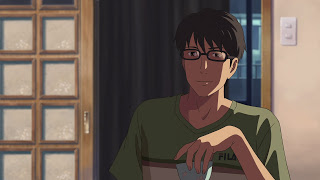


Snuckerpooks
June 5, 2013 at 2:48 pmI absolutely loved this movie. I can't put my finger on why but everything just comes together beautifully. Not to mention, the music CD for this movie is incredible!
This was a day 1 purchase for me and I am very happy to support it.
Taara535 (Michael)
June 5, 2013 at 3:47 pmFirst, I have to say I love any of Makoto's works. They are absolutely brilliant, visual stunning, and beautiful pieces of film.
That said, I have to say, by the end of the movie, I had mixed feelings about Kotonoha-no-niwa. It had more ups and downs for me than some of his other works.
The first 20-30 minutes of the film are a masterpiece in my opinion. The montage of both Akazuki and Yukino moving closer to each other on the park bench is one of the best 3-4 minutes of animation I have ever seen. It captures the essence of a budding and important relationship between two characters.
Unfortunately, the climax, while still poignant and very very well done, did not live up to the masterful first section. I feel this is a flaw with the plot more than anything else. Instead of having Yukino being a teacher at his school, she was working at cafe he had frequented, or perhaps a hardware store where he bought leather to make his shoes – I think this would have been a better set-up for the story Makoto was trying to tell.
The most emotional thread of the climax, for me, was not a stereotypical two "star-crossed lovers" theme, but rather was a gap between a 15 year old who has great dreams for his career and is eager to realize them and a 27 year old who feels lost in her career and has lost those dreams she had when she was younger. I believe putting Yukino in a clearer "working world" than school, would have better contrasted the two characters and have made their connection all the more remarkable and special.
But, as I said, I still loved this movie. I watched it twice in the same day just to make sure I took in every detail of it. I just feel like with a small change in the plot, it could have truly been a masterpiece, and as a whole, surpassed 5 centimeters per second.
ishruns
June 5, 2013 at 5:24 pmI remember watching the Disney short 'Paperman' at the theaters before "Wreck it Ralph' and that silent, black and white, hand drawn animation was so much more touching than the whole family feature film.
In many ways I feel the same with Makoto Shinkai, that he is at his very best when painting a story with his visuals rather than using speech to move the story. That he makes the simple, little thing of life become the best parts of it.
He doesn't wow and nor does he need to or be expected to. He simply leaves us feeling a sense of wonderment and of contemplation. On my first ever jog in Canada, I found a small, free for all Chinese garden. It had a little wooden entrance with some rules written out and no visitors. There was a gravel path, just wide enough for two people to walk side by side, that snaked through it so people could see the trees, small stream, mossy rocks and ducks. At its center, on top of the stream was a bridge hut. I spent days jogging to this place and waiting for my breath to return as I the leaves rustled in the wind. It was a calming place, a place for yoga and admiration for a small patch of green heaven in a city.
It was like Kotonoha no Niwa. The world seems to disappear and you enter a small universe of your own. You can hear the rest of the world out there and you know you must return to it but for now this place and this movie is the world and it is the better one.
hashi
June 5, 2013 at 6:46 pmGreat review. Shinkai is indeed "it," as far as I am concerned. "More real than real," or, as I sometimes say, like haiku. Like great haiku, his work brings us face to face with details that carry a sense of immediate reality. Like 5cm/sec, this is a religious anime, a Buddhist anime, conveying the reality and wabi/sabi and aching unsatisfactoriness of the world.
I have just blocked from my mind Hoshi o Ou Kodomo, which is so much less than his other works. I hope it found an audience and he made money from it, so that he can do more shows like this. This may not be quite at the level of 5cm/sec, but it is at a very high level indeed.
Kurama Hitsugaya
June 5, 2013 at 9:07 pmI can't wait until August when this is released in the U.S.
kanin
June 6, 2013 at 12:05 amAm I the only person in the world who doesn't like 5cm/s nor any of his other films? Still, I loved this one dearly, by far the best animation film I've even seen, both art and story-wise, and was waiting for your review.
Maybe it was the realistic-yet-hopeful ending; when I started, I wasn't expecting to like anything other than the artistry, thinking "we already know how this will end", but I was right and wrong at the same time. Their feelings just felt so right and obvious, and so did the ending even though it leaves so much left to interpretation. I got a good cry out of this one, and will definitely hold it in high regard for many years to come.
litho
June 6, 2013 at 1:15 amI can sort of relate to your opinion. I think a lot of his past work is a tad overrated. Loved Kumo no Mukou, but I felt 5cm just tried way too hard, especially in the last third. With Hoshi no Koe; I can sort of overlook the flaws since it was such an 'indie' type work (just him, his PowerMac and his wife as the VA, I think) that completely caught me out of the blue. Hoshi o Ou Kodomo was just mediocre by my reckoning – he may tried too hard to be himself in 5cm, but there he tried to be someone else and failed miserably.
Also don't quite agree with Enzo's opening sentence about the artistry. The people at Studio 4°C have done way more for me than Shinkai ever did. Highly personal thing, I realize. Watching even the best Shinkai animation (like this one) doesn't quite make me glee like a kid like I do with Spirited Away or Toki o Kakeru Shoujo, nor does it make my jaw drop in awe like in Studio 4°C shorts/features/commercials. It always feels that Shinkai is (particularly in 5cm/sec and Kotonoha no Niwa) sort of painting over still photos, while the stuff I tend to prefer must make me feel that they were drawn on completely blank canvas. Both equally viable techniques, no doubt, but I tend prefer the latter method. Other than that, I've always preferred art that's more 'out there'. More agent provocateur (within reasonable limits) than wabi/sabi, I suppose, which is why I'll always place Satoshi Kon (Millennium Actress is peerless) above Makoto Shinkai in my listings. Like I said, purely personal taste.
Now on to Kotonoha no Niwa. Short answer; I liked it a lot. Probably my favourite work of his along side Kumo no Mukou. It does have it's flaws though. The 2nd half felt a tad rushed, pacing wise. Maybe he was trying to gradually increase the 'cadence' (for lack of better term) as the show went on, I cannot say. Didn't quite pull it off in my opinion, purely due to the nature of the story. Also, like others here, the bits were silence (unspoken words) were much stronger than the bits with voice acting. Not saying the seiyuus did a bad job, but again, it's just the nature of the story and presentation – lends itself to one method more than another.
Last nitpick – Shinkai seemed undecided whether this show should be about one person (the guy) or two. It kind of meanders between those. Can't quite find the words to describe this bit, sorry. Just feels like he started writing this with the two of them in mind, but later just shifted focus to the bloke, using the chick as a fulcrum. The last crying scene went some way to restoring the chick's point in the story, but I still can't help feel that she was cast aside midway through the storytelling phase.
Still, I enjoyed what I saw. The pacing in the first half was brilliant. The animation, lighting effects and frame composition were superb. The overall atmosphere was decent (well, as decent as a 24" monitor and headphones would allow it to be). Another plus point is the way it didn't cheapen out by dwelling on the whole age-gap thing too much. Brilliant moments of understatement throughout.
Overall, 4 stars.
Not bad for a show about a boy and his foot fetish.
kanin
June 6, 2013 at 3:45 amI agree with everything you've said, except I'm on the side that venerates Shinkai and his production team as artistry gods. The second half does feel rushed — I think the movie could have done better with a lenght of 60min or so in order to flesh out Yukino — but I'm one to overlook such things if the overall impact is as remarkable as this movie was for me. Let's only hope he finds a balance between being himself and finding time and budget to fully develop the story, as Kotonoha no Niwa felt even more like a cut version of an actual film than 5cm.
Kurama Hitsugaya
June 6, 2013 at 5:24 am@ litho: People have different opinions, I really didn't like the art style in Spirited Away. So much so that I couldn't watch it all the way through on my first viewing. It really put me off. I get that it was mostly hand-drawn and was going for a warm, organic style, but I didn't see the appeal. I found the visuals dull and austere.
fantasticmemes
June 6, 2013 at 1:19 amOh my goodness, this review was just so beautifully written. I think I have a bit of a tear in my eye after reading this. I think you've managed to capture the beauty of the film in words, and that's an art too.
admin
June 6, 2013 at 1:47 amThank you very much for that – I can hardly think of a kinder comment you could have made.
justinnm
June 6, 2013 at 4:19 amIt really was beautiful – thanks for writing about this, you made me watch it!
jackandmathew
June 7, 2013 at 11:29 am"Life imitates Art far more than Art imitates Life"
-Oscar Wilde
Maxulous
June 15, 2013 at 6:39 pmFirstly, I haven’t seen a lot of Makoto Shinkai’s films, only his very early She and Her Cat and his relatively conventional Hoshi o Ou Kodomo. But I know enough about him to understand his modus operandi in constructing attractive visuals to lyrically communicate a gentle story of few words and big emotions. And I think above all else, Shinkai is a talented painter who must do wonders for Japanese tourism…
Fundamentally the two films I had seen prior to Kotonoha no Niwa are vastly different and therefore didn’t really prepare me for how I would react to this one. Initially it took a while for me to adjust to the world I was observing since the visuals were rather obtrusive but I eventually got on board the train. My reaction to the first 20 minutes was mostly fascination. They cast forgivingly simple premises for Takao and Yukino – two supposed strangers crossing paths who develop a strong rapport with one another. One feels trapped in their adolescence; while the other can’t escape (i.e can’t walk). I had supposed we would follow the tale of the aspiring shoemaker who would empower this aimless woman by helping her craft the steps to move forward with her life.
Instead, I couldn’t quite shake a feeling of unease 25 minutes in. Michael mentioned this above, but revealing Yukino to be a teacher (one at his own school no less) completely robbed the narrative of its realism. Takao is also a jarring element in this aspect because of Shinkai’s almost fetishistic portrayal in a deeply profound 15 year old. The excessively mature conduct and perfectly posed nature of this adolescent was on a human level, disturbing (Shinkai could learn a thing or two about complex teen portrayals in Kasuga here). His bawwing outside her apartment felt incredibly out of place and emotionally undeserved because of this. The problem came when Shinkai over complicated his story by devising a professional link between the characters. The healing that needed to be made here was indeed rash and idealised at best.
And that’s probably my biggest issue with Shinkai. His portrayal of reality isn’t the least bit natural to me. Humans don’t act the way he has construct them to. A sane teacher doesn’t willingly encourage an interrelationship with a student especially when she’s been accused of an affair with another. A 15 year old boy isn’t so adjusted a person to externalise empathy on the level of an adult. An accumulation of events and emotions don’t just idealistically fall into place when the rain falls or thunder claps. A sense of innocence is also lost, and cheapens the emotions that come pouring heavy as the rain. Earned emotions are certainly at play here – but unfortunately the focus is misplaced. Yukino’s is the one this story should centre on and I wouldn’t doubt for a second that Miyazaki, Takahata (and especially late Satoshi Kon) would approach similar material in this manner.
Shinkai also struggled to balance the lyricism of his writing and visuals. Together both are overwhelming, although the visuals usually come on top – if not highly self indulgent manner. Both compete for the same resonance. Perhaps you could impart my reaction to a general lack of exposure to Shinkai’s oeuvre but mostly a failing believability in the story he’s trying to sell.
Anyone who completely resonated with the portrayal of life in this film must have a very privileged and/or guarded impression of reality. ‘Realer than real’ couldn't be further from the truth for me.